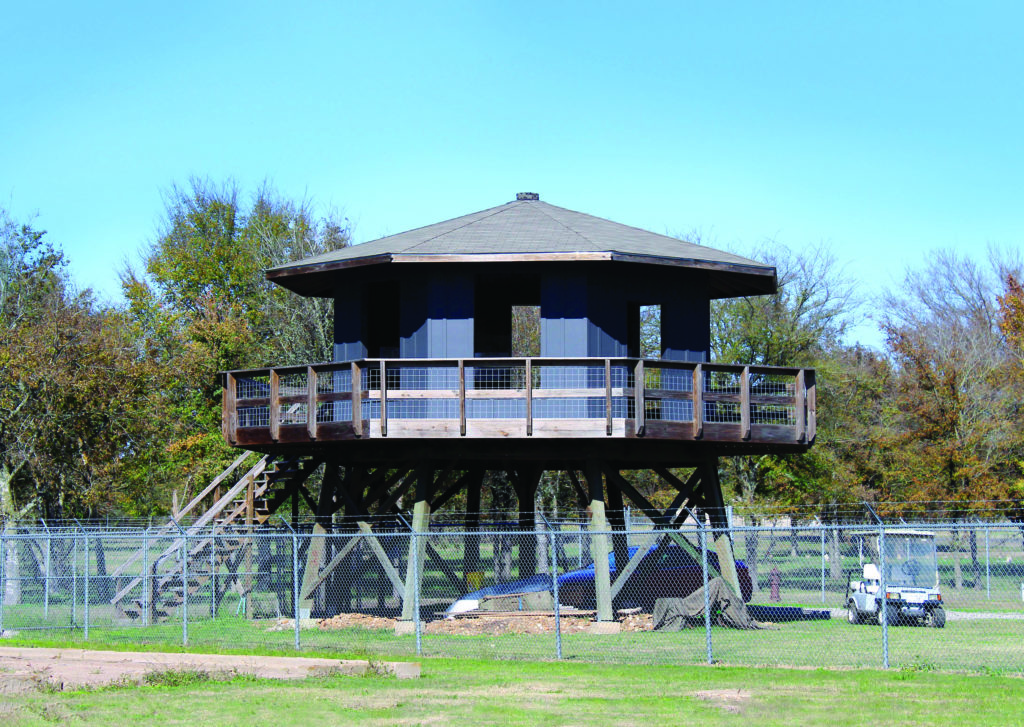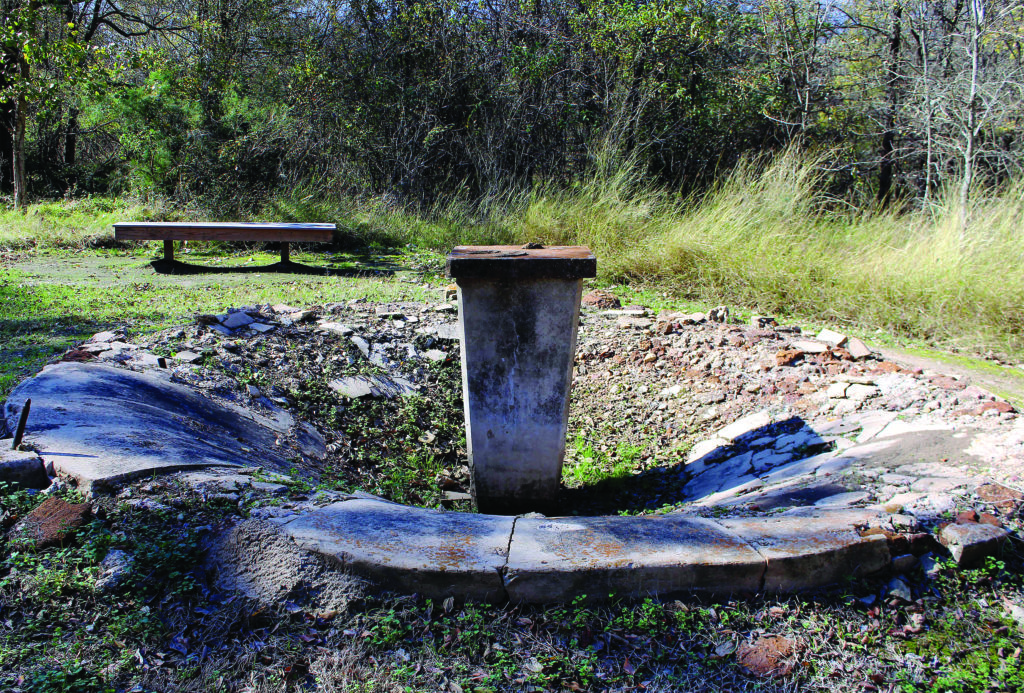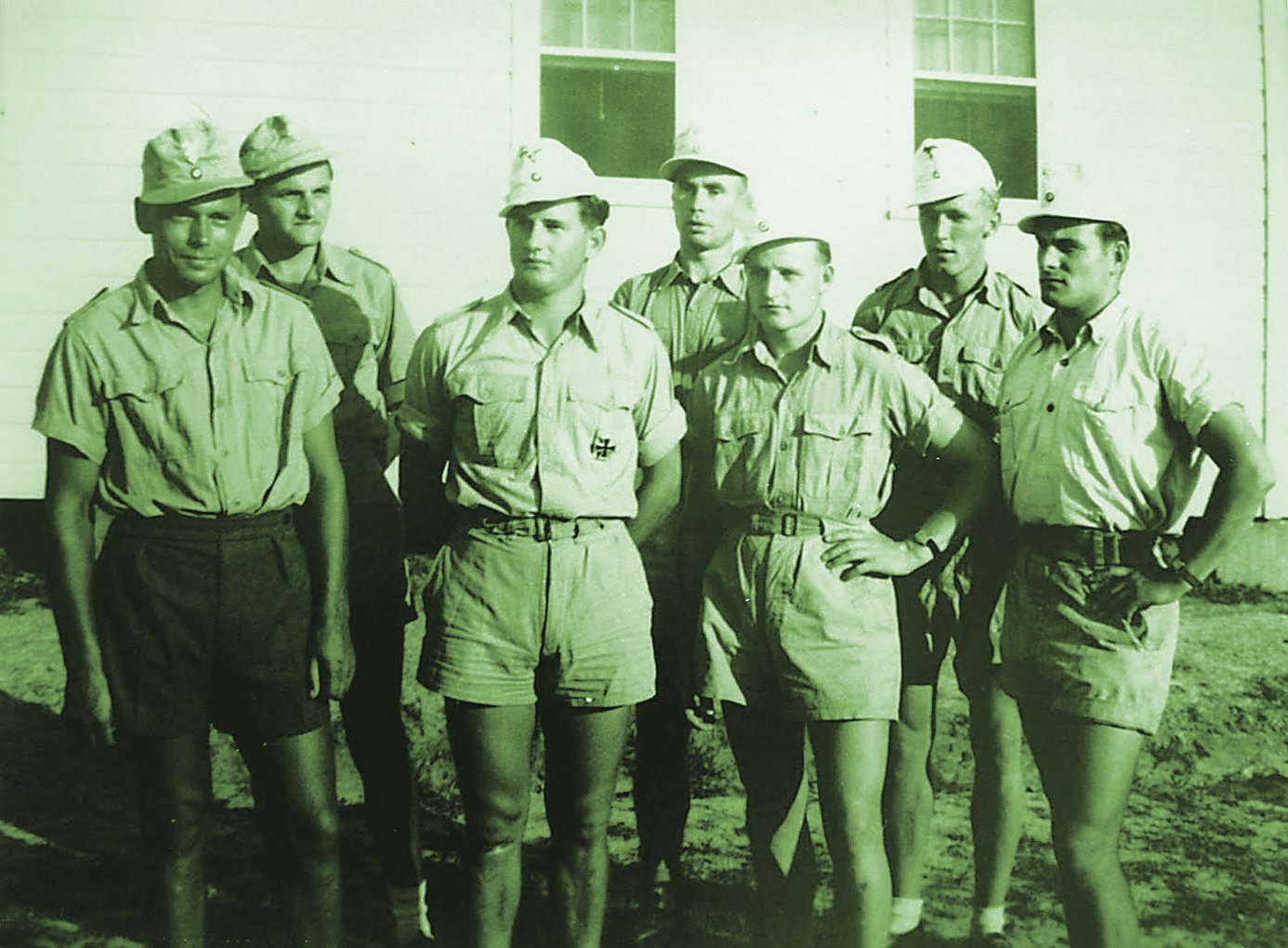Hearne, Texas, sits almost in the middle of a triangle with corners located at Dallas, San Antonio, and Houston. The two-hour drive through the pan-flat countryside from the Dallas area would be straightforward except for a Texas-sized rainstorm that at times makes it seem I am driving through a waterfall. Thankfully, when I reach the sign for the Hearne city limits, the rain has just about stopped—though the gray skies and chilly temperature make a fitting backdrop for my destination, a site that 4,700 German soldiers called home between 1943 and 1946.
The camp would have remained in obscurity, like the 70-odd other prisoner-of-war camps in Texas, if it weren’t for Professor Michael Waters of Texas A&M’s Department of Anthropology. As a result of an archeological dig he and his students performed in 1995, the Camp Hearne Museum, housed in a replica 1942 U.S. Army barracks next to which I park my rental car, contains a treasure trove of memorabilia that gives me a taste of what it was like for some of the nearly 450,000 Axis POWs held in captivity in the United States during the war.
As I enter the museum, hanging on a rack to my right is a lightweight uniform worn by Field Marshal Erwin Rommel’s Afrika Korps. This uniform is key to why Texas was chosen to house so many German POWs. After vanquishing Rommel’s bedraggled troops in 1943, the British didn’t know what to do with the thousands of captured Germans. Churchill had enough difficulties caring for his own citizens—plus he had 273,000 Axis prisoners of his own to contend with—and so he turned to his ally, President Franklin D. Roosevelt. FDR agreed to lend a hand, and soon ships laden with German soldiers were unloading their cargo in New York, to be sent by train to destinations that complied with the 1929 Geneva Convention. According to the convention’s terms, prisoners dressed in lighter-weight uniforms had to be sent to camps in warmer climes. This is why nearly 78,000 German POWs from North Africa came to be sheltered in hastily assembled camps in various parts of Texas—including the one in Hearne.

Camp Hearne opened its doors to the first batch of German POWs in June 1943. The compound covered 720 acres and contained nearly 150 buildings—including the many barracks, mess halls, administrative offices, and a hospital—and was surrounded by 1,800 miles of double barbed-wire fence guarded by military police who mostly stayed in raised towers around the perimeter. Walking on the rain-sodden grounds, I see only concrete foundations—all the buildings were disassembled after the war and carted away. The only original structure remaining is the rusty, vine-covered water tower down the road from the museum.
The museum itself, opened in 2010, is much larger than I’d imagined and includes a reconstructed guard tower and water tank in addition to the displays within the barracks. I’m surprised to learn that it still regularly receives new artifacts, sent by family members of prisoners, guards, and residents of the area, including some that came in only a few days before I had arrived.
While the barracks housing the museum is a replica, it’s a faithful reproduction of an original wartime version and includes ventilation baffles in the eaves to allow some of the summer’s hot air to escape. And though the buildings certainly became hot in summer months, every effort was made to obey the rules of the Geneva Convention and make the POWs feel relatively comfortable.

Actually, according to Hearne’s residents, the POWs were entirely too comfortable, which is why they labeled the camp the “Fritz Ritz.” Rationing often left locals with less food than the POWs, who received the same quantities provided to American troops based on home soil. My guide tells me an anecdote that highlights this disparity: sugar for ordinary Americans was rationed, and when a little girl in town made cookies for her mother’s birthday, she was scolded for using up the family’s monthly allotment. Meanwhile, the POWs at Camp Hearne had so much that when they ran out of chalk to mark their soccer field, they used their excess sugar supply instead.
Hearne’s municipal leaders had requested a POW camp because they hoped to use the inmates as replacement workers while the town’s residents served overseas. But while a number of the camp’s enlisted men picked cotton and other crops—for which they were paid a reasonable wage—the bulk of the internees were non-commissioned officers, whom the Geneva Convention exempted from labor. Recreation, therefore, became a big part of their daily activities. In addition to soccer, the POWs played volleyball and handball and built themselves a track and a pool. They also constructed an outdoor stage—the concrete foundation of which is still visible—complete with a pit for their orchestra, at times led by a relatively famous conductor, Willi Mats, director of the Leipzig Symphony. The POWs additionally turned one of the barracks into a concert hall and performed for not only their fellow prisoners but also the residents of Hearne. I spend some time staring at a picture of that theater, amazed at how much freedom the POWs were permitted under their supposed captivity. The musicians were even wearing white tuxes.
Camp officials also provided the POWs with wood, cement, paint, and other art materials to help them occupy their time. Among the more fanciful works created were 12 elaborate fountains scattered around the camp, as well as a highly detailed miniature replica of a German castle.

As I walk the grounds, I examine some of the remnants. Unless you’re an archeologist, what’s left appears to be nothing more than stone debris strewn about. However, when I see the photos and artwork on display in the exhibit, I begin to admire the prisoners’ abilities. With the wood some made furniture, including a well-crafted table and desk, while others produced colorful paintings, often depicting the camp setting. And while the prisoners had been stripped of all weapons and Nazi insignia before boarding the ships, in one of the display cases I see both swastikas and homemade weapons. Obviously, they sometimes used their artistic abilities in nefarious ways.
When I ask my guide why one case displays a glass jug, she explains that making moonshine was another of the POWs’ skills, though they could also purchase beer. (All prisoners were given a 10¢ daily allowance.) Since camp authorities limited each POW to one beer per day, groups of seven coordinated so that each prisoner could get blitzed once a week.
At first, Hearne was a rather peaceful place to wait out the end of the war, but then some hardcore Nazis arrived. This small band took control of the camp, greatly restricting life for the other POWs. For example, my guide tells me, many men had initially attended religious services, but few dared to once the Nazis began watching their every move. On the wall, I see the photo of one soldier, Hugo Krauss, who didn’t join the others in singing German songs and preferred to listen to American radio. This made him suspect in the eyes of the true Nazis, so one night a group of seven men armed with wooden planks went to Krauss’s bunk and beat him to death. This “Nazification” of internment camps also played out at other German POW compounds around the country.
The Nazi NCOs volunteered for one job in particular. Mail sent from Germany to prisoners throughout the U.S. had been piling up in New York, and the Camp Hearne Nazis offered to sort through it. They were so efficient that very soon the two tons of mail were on their way to other camps across America, and Camp Hearne became a Central POW Post Office. However, hidden under the flaps of the envelopes were messages informing the recipients that they’d better remain loyal to the Third Reich or else Nazi diehards in their camp would exact punishment—or alternatively the Gestapo would do so to their families back in Germany. This ploy wasn’t discovered until after the war ended.
Until then, these dedicated Nazis were still preparing for the anticipated German victory over the Allies, at which point they intended to rise up and create havoc throughout the United States. On learning their plans, any admiration I’d developed for these prisoners evaporated. And that’s why I say the gloom I encountered on my visit was appropriate—because Camp Hearne wasn’t just a compound where prisoners of war were housed, but also the setting where the enemy was engaged in a plot to destabilize the United States from within. ✯
When you go
The city of Hearne has a small airport and several train lines run through it, but the easiest way to visit Camp Hearne is by car. Dallas, Austin, and Houston are each about a two-hour drive away, while San Antonio is a three-hour drive southwest.
WHERE TO STAY AND EAT
To sample the local chicken-fried steak, a Texas staple, try Hearne’s Dixie Cafe, Penny’s Diner, or Maxie Lewis Bar BQ & Soul Food. Otherwise, dining options in Hearne are mostly confined to standard fast-food restaurants. The town has a couple of chain hotels, the Holiday Inn Express being the cream of the crop. College Station, 25 miles southeast, boasts a much wider range of lodging and dining options and makes for a better base of operations.
WHAT ELSE TO SEE AND DO
Because of the multiple railway lines that intersected in Hearne, the city was many years ago a major transportation hub labeled the “Crossroads of Texas.” The old railway station is now a small museum, the Hearne Railroad Museum Depot. In nearby College Station, you can visit the George H. W. Bush Presidential Library Center, which features an authentic presidential limousine, and the excellent Museum of the American GI, both on the campus of Texas A&M University.
—Pierre A. Lehu, who earned both his bachelor’s degree and a master of business administration from New York University, is the author of 25 books.
This article was published in the December 2019 issue of World War II.






